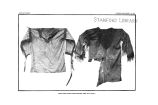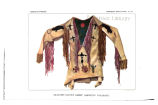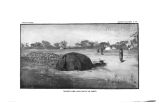| OCR Text |
936 THE GH08T- DANCE RELIGION [ BTH. AICM. U memory of the thirty- three years of Christ's life. The strokes of the whip were timed to the music of hymns. Men and women together took part in the scourging. The mania Anally wore itself out, but reappeared in 1349 with more systematic organization. According to Schaff, u When they came to towns, the bands marched in regular military order and singing hymns. At the time of flagellation they selected a square or churchyard or field. Taking off their shoes and stockings and forming a circle, they girded themselves with aprons and laid down flat on the ground. . . . The leader then stepped over each one, touched them with the whip, and bade them rise. As each was touched they followed after the leader and imitated him. Once all on their feet the flagellation began. The brethren went two by two around the whole circle, striking their backs till the blood trickled down from the wounds. The whip consisted of three thongs, each with four iron teeth. During the flagellation a hymn was sung. After all had gone around the circle the whole body again fell on the ground, beating upon their breasts. On arising they flagellated themselves a second time. While the brethren were putting on their clothes a collection was taken up among the audience. The scene was concluded by the reading of a letter from Christ, which an angel had brought to earth and which commended the pilgrimages of the Flagellants. The fraternities never tarried longer than a single day in a town. They gained great popularity, and it was considered an honor to entertain them." ( Schaff, Religious Encyclopedia.) The society still exists among the Latin races, although under the ban of the church. As late as 1820 a procession of Flagellants passed through the streets of Lisbon. Under the name of Penitentes they have several organizations in the Mexican towns of our southwest, where they periodically appear in processions, inflicting horrible self- torture on themselves, even to the extent of binding one of their number upon a cross, which is then set up in the ground, while the blood streams down the body of the victim from the wounds made by a crown of cactus thorns and from innumerable gashes caused by the thorny whips. Such things among people called civilized enables us to understand the feeling which leads the Indian to offer himself a willing sacrifice in the sun dance and other propitiatory rites. RANTERS, QUAKERS, AND FIFTH- MONARCHY MEN The middle of the seventeenth century was a time of great religious and political upheaval in England. Hatreds were intense and persecutions cruel and bitter, until men's minds gave way under the strain. uThe air was thick with reports of prophecies and miracles, and there were men of all parties who lived on the border land between sanity and insanity." This was due chiefly to the long- continued mental tension which bore on the whole population during this troublous period, and in particular cases to wholesale confiscations, by which families were ruined, and to confinement in wretched prisons, suffering from |





























